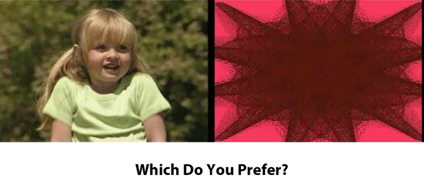Archived Content
The National Institute of Mental Health archives materials that are over 4 years old and no longer being updated. The content on this page is provided for historical reference purposes only and may not reflect current knowledge or information.
Preference for Moving Shapes vs. People Linked to Autism in Babies
• Science Update
A 1-minute video showing computer screensavers next to videos of dancing children may prove to be a simple, inexpensive screening tool for autism spectrum disorders (ASD) in toddlers. According to an NIMH-funded study, infants as young as 14 months old who had autism spent more time looking at the moving shapes than social images, in contrast to typically developing children and those who had delays but not autism. The study was published online, September 6, 2010, in the Archives of General Psychiatry.
Background
Among the hallmark signs of ASD are repetitive behaviors, which may include persistent and intense preoccupation with objects. For example, a child with ASD may fixate on moving objects or parts of objects, like the moving blade of a fan or spinning tires on a car. Whether this behavior could predict or identify ASD in very young children had not previously been studied.
About the study
To study this phenomenon, Karen Pierce, Ph.D., at the University of California San Diego School of Medicine, and colleagues enrolled 110 toddlers, ages 14-42 months. Of this group, 37 had ASD, 22 were developmentally delayed (DD) but did not have ASD, and 51 had typical development (TD).
The toddlers viewed a 1-minute video showing geometric patterns on one side—basically a computer screensaver—and children exercising, dancing, or otherwise in action on the other side. Using eye tracking technology, the researchers measured how long the toddlers looked at each type of movement and how many times they switched from looking at one type or part of an image to another.
Results
In this study, 40 percent of toddlers with ASD spent significantly more time fixating on moving geometric patterns compared with 9.9 percent in the DD group and 1.9 percent of TD children. The other 60 percent of toddlers with ASD performed similarly to their DD and TD peers, showing a preference for social movement. If a toddler spent more than 69 percent of the time fixating on geometric patterns, ASD could be predicted 100 percent of the time.
While viewing the video, DD and TD children tended to let their eyes wander, changing their focus from one part of an image to another. Among toddlers with ASD, however, those who preferred geometric patterns showed significantly less eye movement when viewing geometric patterns, gazing at only a few parts of an image for extended periods of time. These children also showed significantly more frequent eye movement than DD or TD toddlers when viewing social movement.
A subsample of 41 toddlers were re-tested an average of 8 months later. The researchers found that the toddlers' preferences generally stayed the same between the original study and the follow-up.
Significance
The results suggest that assessing infants' visual preference for geometric vs. social movement, including the amount of time they spend staring at moving geometric patterns, is an inexpensive and easy-to-conduct screening method for ASD.
"What an infant prefers to look at when given a choice between two images may turn out to be a more clearly observable indicator of autism risk than how he or she looks at a single image," Pierce said.
That most of the toddlers with ASD in this study responded in the same way as DD and TD children came as a surprise to the researchers. They suggest that differing patterns of brain activity may underlie toddlers' preference for geometric or social movement. Brain imaging studies would help to confirm whether subgroups of ASD can be distinguished by brain activity patterns.
What's Next
According to the researchers, this screening tool may also be useful in identifying babies who would benefit from further developmental evaluation or even early treatment. The findings also provide new lines of inquiry regarding the role of various brain regions involved in processing social cues and shifting attention in the development of ASD.

Sample "social" image (left) and "geometric" image (right) from Pierce's eye tracking study. Forty percent of babies later diagnosed as having autism preferred to look at the moving geometric images, in contrast to just 2 percent of typically developing babies.
Reference
Pierce K, Conant D, Hazin R, Stoner R, Desmond J. A Preference for Geometric Patterns Early in Life is a Risk Factor for Autism . Arch Gen Psychiatry. 2010 Sep 6. [Epub ahead of print]
